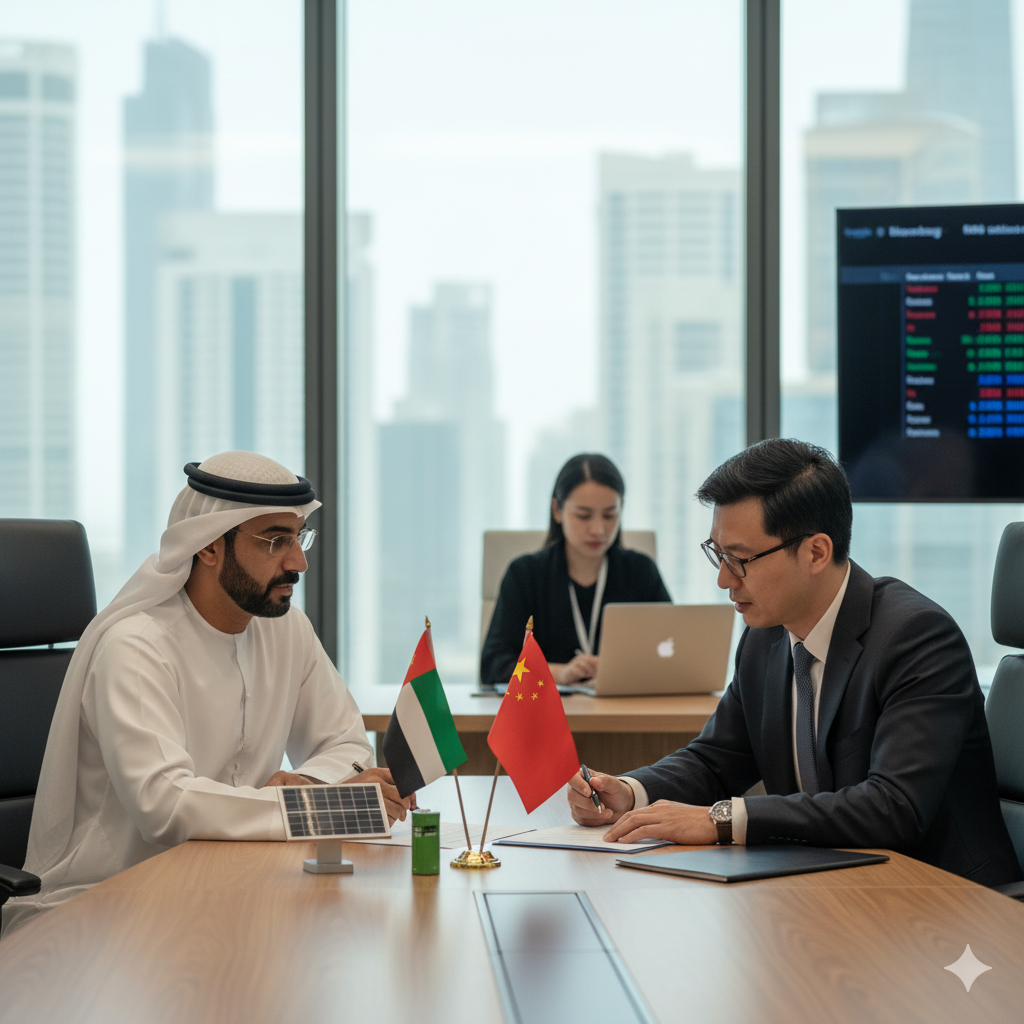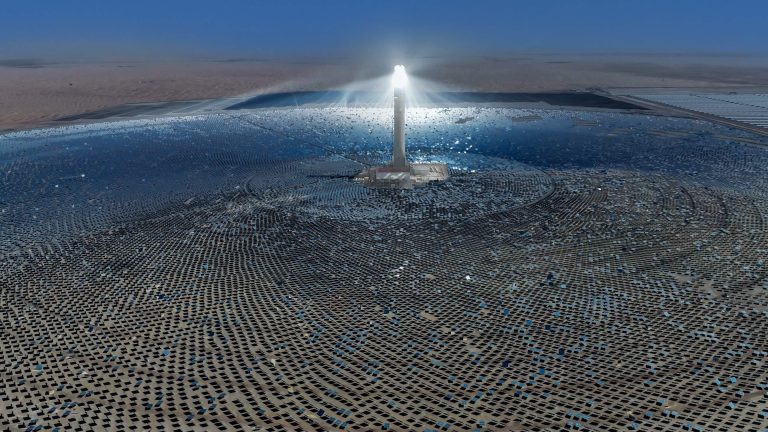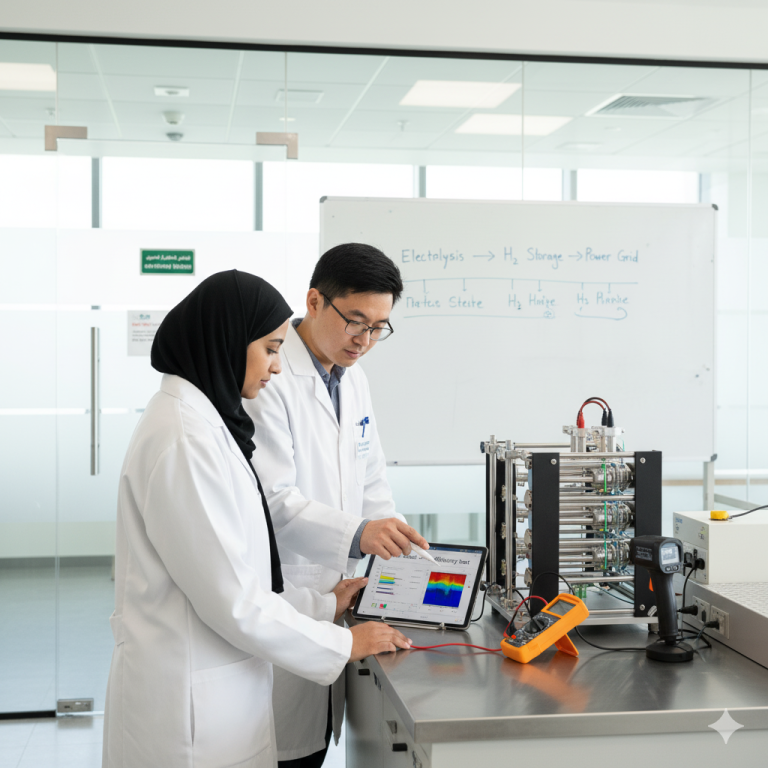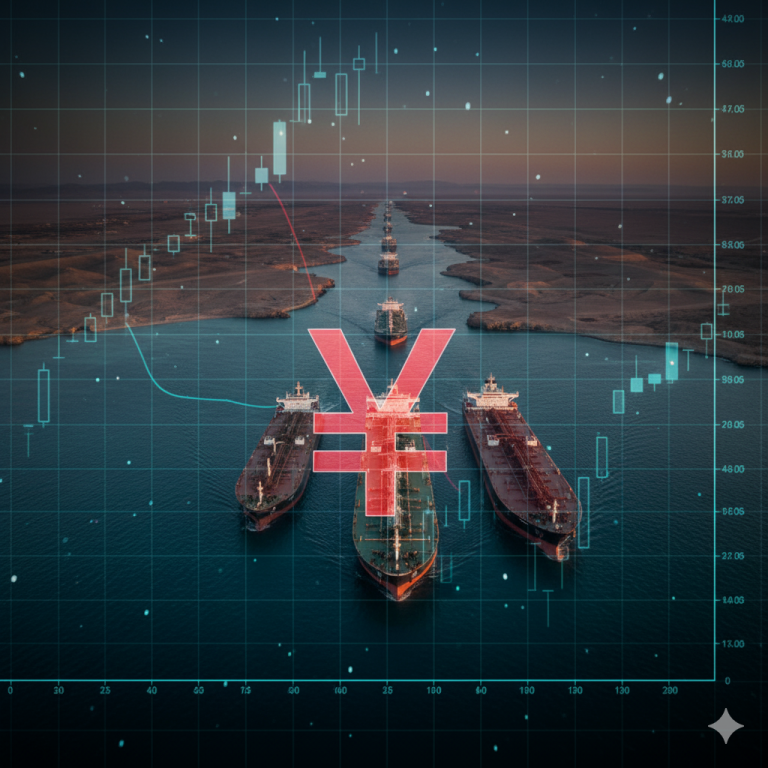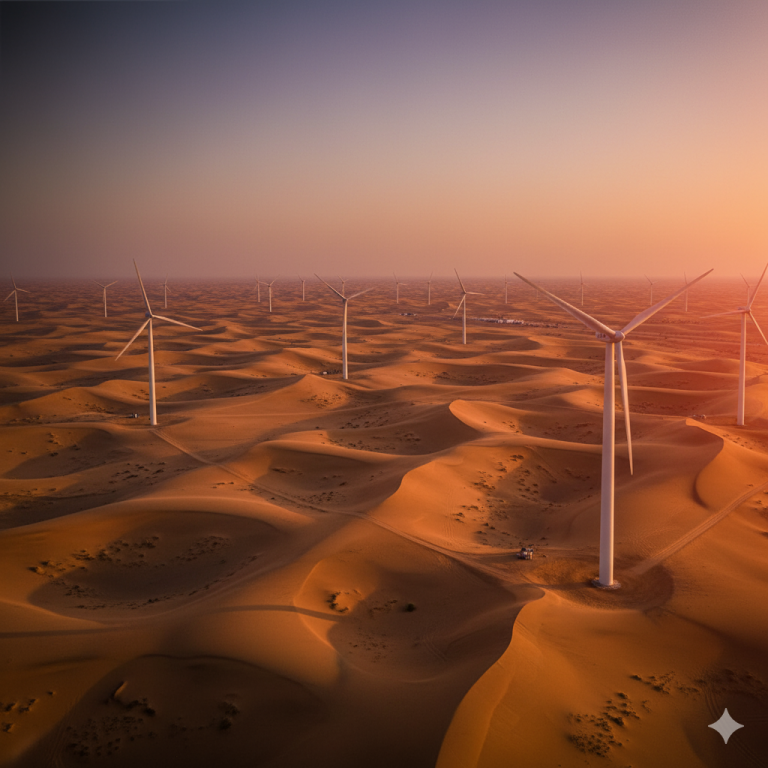Financing the Future: The Role of Capital in the Energy Transition
Both China, as the world’s largest energy consumer and an unparalleled manufacturing powerhouse, and the UAE, a historically oil-rich nation with increasingly ambitious diversification goals, acutely recognize the strategic imperative of this global energy transition. Their bilateral collaboration, once primarily rooted in the robust trade of traditional hydrocarbons, has rapidly evolved into a dynamic and forward-looking alliance with a sharp focus on green energy. This in-depth article will meticulously delve into the multifaceted dimensions of this evolving partnership, thoroughly exploring its historical trajectory, the powerful industrial synergies that underpin it, and the pivotal role of capital in shaping its promising future. We will argue that the China-UAE energy cooperation, underpinned by strategic financing mechanisms and a shared vision for a sustainable future, is not only significantly accelerating their respective national energy transitions but also offering a compelling and replicable model for global decarbonization efforts. This alliance, characterized by profound mutual benefit, strategic foresight, and substantial forward-looking investments, stands as a powerful testament to the transformative power of international collaboration in addressing one of humanity’s most pressing and complex challenges: securing a sustainable and prosperous energy future for all.
II. Historical Foundations: From Oil to Renewables
The relationship between China and the United Arab Emirates has historically been anchored in the robust trade of hydrocarbons, forming a cornerstone of their bilateral economic ties. For many decades, the UAE, as a significant global oil producer and exporter, served as a crucial and reliable supplier to China’s burgeoning economy. China, in turn, demanded vast quantities of energy to fuel its rapid industrialization, urbanization, and economic expansion. This traditional energy partnership was characterized by long-term supply agreements, strategic partnerships, and substantial investments in both the upstream and downstream sectors of the oil and gas industry. Notably, major Chinese national oil companies, such as the China National Petroleum Corporation (CNPC), have actively participated in the UAE’s offshore concessions, thereby securing vital energy resources for China while simultaneously contributing to the advanced development of the Emirates’ petroleum infrastructure and expertise [1]. This foundational era fostered a strong sense of economic interdependence and mutual trust, which would later prove to be an invaluable asset in navigating the complex and often challenging landscape of the global energy transition.
However, as global awareness of the escalating climate crisis intensified and the economic viability and technological maturity of renewable energy solutions dramatically improved, both nations began to strategically pivot their long-term energy strategies. The UAE, under its visionary and proactive leadership, embarked on an ambitious and comprehensive journey to diversify its economy away from its historical reliance on oil, setting bold and transformative targets for clean energy adoption and sustainable development. Pioneering initiatives such as Masdar City, a planned city powered entirely by renewable energy, and the overarching UAE Energy Strategy 2050, clearly underscored a profound national commitment to becoming a global leader in renewable energy and sustainable innovation. Concurrently, China, grappling with severe domestic environmental challenges and keenly recognizing the strategic importance of achieving technological leadership in green industries, rapidly scaled up its renewable energy manufacturing capabilities and significantly accelerated domestic deployment. China’s investment in research and development (R&D) for clean energy technologies, for instance, was an astounding 2.5 times the global average spending in 2023, unequivocally showcasing its deep dedication to continuous innovation and technological advancement in this critical sector [2].
This parallel yet convergent evolution in national energy strategies naturally led to a powerful convergence of interests and a deepening of cooperation. Key milestones in this shifting landscape include a series of early agreements on renewable energy projects, technology exchanges, and capacity building initiatives. For example, Chinese companies have played a pivotal role, participating in green projects worth a staggering total of $9.5 billion USD across the broader Gulf region, with a significant portion of this investment concentrated in the UAE, clearly demonstrating a substantial and strategic shift in investment focus [3]. The joint statement issued by the governments of China and the UAE in May 2024 further solidified this burgeoning commitment, explicitly outlining strengthened cooperation in renewable energy, alongside the continued collaboration in traditional oil and gas sectors [4]. These foundational steps, marking a clear transition from a purely transactional oil-for-growth model to a more collaborative, innovative, and future-oriented partnership, have been absolutely critical in setting the stage for the current dynamic era of green energy cooperation and investment between these two influential nations.
III. Industrial Perspective: Driving Innovation and Scale
The industrial collaboration between China and the UAE in the energy transition is a testament to their complementary strengths, creating a powerful synergy that accelerates innovation and scales deployment. China has firmly established itself as the undisputed global leader in renewable energy manufacturing, possessing unparalleled prowess in the production of solar panels, wind turbines, and electric vehicle batteries. This industrial might has not only driven down global costs for green technologies but has also significantly accelerated their adoption worldwide. Chinese companies, such as LONGi Green Energy Technology, Jinko Solar, and Goldwind, dominate global supply chains for critical components in renewable energy projects, making them indispensable partners for nations committed to decarbonization [5]. This manufacturing capability is characterized not just by sheer volume but also by continuous innovation, leading to more efficient, durable, and cost-effective solutions that are crucial for the rapid scaling of global renewable energy infrastructure.
Conversely, the UAE has demonstrated a visionary approach to energy diversification, strategically leveraging its substantial capital and advantageous geographic location to become a global hub for large-scale renewable energy projects and sustainable development. Entities like Masdar, Abu Dhabi’s renewable energy company, have been at the forefront, investing heavily in pioneering solar power plants, vast wind farms, and other clean energy initiatives, both within the UAE and internationally. The UAE’s unwavering commitment is vividly evident in landmark projects such as the Mohammed bin Rashid Al Maktoum Solar Park in Dubai. This ambitious undertaking, set to be one of the largest single-site solar parks in the world upon completion, has attracted significant international participation, including substantial contributions from leading Chinese firms in engineering, procurement, and construction (EPC) [6]. These mega-projects not only play a crucial role in helping the UAE achieve its ambitious clean energy targets but also serve as vital showcases for advanced renewable energy technologies and sustainable urban planning.
The synergy between China’s technological and manufacturing capabilities and the UAE’s investment capacity, coupled with its ambitious project development pipeline, forms a powerful engine for driving the energy transition. Chinese EPC companies and equipment manufacturers are frequently engaged in the UAE’s renewable energy ventures, bringing not only their cutting-edge expertise but also highly competitive pricing, which is essential for the economic viability of large-scale projects. This collaboration extends far beyond mere transactional relationships, often evolving into deeper partnerships involving joint ventures, comprehensive technology transfers, and collaborative research and development efforts. A notable example is the China Three Gorges Corporation’s strategic acquisition of Alcazar Energy Partners, a prominent developer with a portfolio of renewable energy projects across the Middle East. This acquisition underscores the growing trend of Chinese investment in regional renewable energy assets and their commitment to long-term engagement [7]. Such partnerships ensure that the most advanced Chinese clean energy technology is effectively deployed and integrated within the UAE, while Emirati capital provides the necessary financial impetus for these transformative projects to come to fruition. This creates a robust and mutually beneficial ecosystem that fosters innovation, drives economic growth, and accelerates the transition to green energy across the region and beyond.
IV. The Role of Capital: Fueling the Transition
The energy transition, by its very nature, is capital-intensive. The shift from established fossil fuel infrastructure to new, often nascent, renewable energy systems requires colossal financial commitments. In the context of China-UAE cooperation, capital plays an indispensable role, acting as the primary catalyst for accelerating this transition. Bilateral investment flows have become a hallmark of this partnership, with both nations strategically deploying funds to foster green growth.
Chinese investment in the UAE’s renewable energy sector has been substantial, often channeled through state-backed financial institutions and large corporations. These investments are not solely focused on project financing but also extend to the development of manufacturing capabilities within the UAE, technology transfer, and research and development initiatives. Conversely, UAE sovereign wealth funds and private entities have shown increasing interest in China’s advanced renewable energy technologies and manufacturing prowess, investing in Chinese green energy companies and projects. This reciprocal flow of capital underscores a shared belief in the long-term economic viability and strategic importance of the energy transition.
Various financial mechanisms underpin this cooperation. Sovereign wealth funds, such as Abu Dhabi Investment Authority (ADIA) and China Investment Corporation (CIC), are increasingly allocating capital towards sustainable investments, recognizing the dual benefits of financial returns and environmental impact. State-backed loans and development banks, like the China Development Bank, provide crucial financing for large-scale infrastructure projects. Furthermore, the burgeoning market for green bonds and private equity investments in renewable energy startups in both countries signifies a maturing financial ecosystem dedicated to sustainability. These diverse funding avenues ensure a robust pipeline of capital for projects ranging from utility-scale solar farms to innovative energy storage solutions.
Policy support from both governments has been instrumental in facilitating these investment flows. China’s Belt and Road Initiative (BRI) has, in part, served as a framework for green infrastructure development and energy cooperation with partner countries, including the UAE. The UAE, through its national energy strategies and initiatives like the Dubai Clean Energy Strategy 2050, offers attractive incentives and a stable regulatory environment for foreign investment in its renewable sector. These policy frameworks reduce investment risks, enhance transparency, and create a conducive environment for long-term capital deployment. For instance, the UAE’s commitment to achieving net-zero emissions by 2050 has spurred significant public and private sector investment in green technologies, many of which benefit from Chinese technological expertise and capital [8].
Despite the significant progress, challenges remain. These include navigating geopolitical complexities, ensuring equitable benefit sharing, and continuously adapting to rapidly evolving technological landscapes. However, the opportunities far outweigh the obstacles. By fostering innovation through joint R&D, leveraging economies of scale, and developing robust financial instruments, China and the UAE are not only mitigating investment risks but also creating new avenues for sustainable economic growth. Their collaborative approach to capital deployment in the energy sector serves as a powerful example of how strategic financing can effectively fuel the global transition towards a cleaner, more sustainable energy future.
V. Future Outlook: A Blueprint for Global Energy Security
The trajectory of China-UAE energy cooperation points towards an increasingly integrated and impactful future, offering a compelling blueprint for global energy security and sustainability. This forward momentum is significantly bolstered by the strategic alignment of national development agendas. China’s ambitious Belt and Road Initiative (BRI), while often associated with infrastructure development, increasingly emphasizes green development and energy cooperation, positioning the UAE as a crucial partner in its westward expansion of renewable energy expertise and technology. This green dimension of the BRI is particularly relevant, as it facilitates the transfer of Chinese renewable energy technologies and project development expertise to partner countries, including the UAE, thereby fostering a more sustainable global infrastructure network. Concurrently, the UAE’s Vision 2071, which aims to make the UAE the world’s leading nation by its centennial, places a strong emphasis on a diversified, knowledge-based economy driven by innovation and sustainable practices. This convergence of strategic visions creates fertile ground for deeper collaboration in the energy sector, ensuring that both nations benefit from shared goals and coordinated efforts.
Looking ahead, the partnership is poised to explore and invest in emerging energy technologies that will define the next wave of the global energy transition. Hydrogen, particularly green hydrogen produced from renewable sources, is a key area of mutual interest. Both nations are investing heavily in hydrogen production, storage, and transportation infrastructure, recognizing its immense potential as a clean fuel for various sectors, including heavy industry and transportation. The UAE, with its abundant solar resources, is well-positioned to become a leading producer of green hydrogen, while China offers vast market demand and technological expertise in its production and application. Carbon capture, utilization, and storage (CCUS) technologies also present significant opportunities for collaboration, especially given the UAE’s existing oil and gas infrastructure, which can be repurposed for CCUS projects, and China’s industrial scale and commitment to reducing emissions from hard-to-abate sectors. Advanced energy storage solutions, crucial for grid stability and the seamless integration of intermittent renewable energy sources, are another frontier where joint research and development, as well as commercial deployment, are expected to flourish. This includes battery storage, pumped hydro, and thermal energy storage, all vital for a resilient and efficient green energy grid.
The global impact of this burgeoning partnership cannot be overstated. As two influential economies with significant stakes in the global energy market, their collaborative efforts in accelerating the energy transition can serve as a powerful model for other regions, particularly developing nations seeking to decarbonize their economies. By demonstrating the economic viability and strategic benefits of transitioning to a low-carbon economy, China and the UAE are not only contributing significantly to global decarbonization targets but also fostering a new paradigm of international cooperation based on shared environmental responsibility and economic opportunity. Their joint ventures and shared expertise can help de-risk investments in emerging markets, facilitate the transfer of critical technologies, and build local capacities, thereby democratizing access to sustainable energy solutions worldwide. This collaborative approach can inspire other nations to pursue similar partnerships, creating a ripple effect of green development across the globe.
To sustain this momentum and maximize its long-term benefits, a comprehensive and adaptive long-term vision is essential. This involves continuous policy dialogue to harmonize regulatory frameworks and investment incentives, fostering greater private sector participation through attractive financing mechanisms and public-private partnerships, and investing significantly in human capital development to cultivate a skilled workforce capable of driving innovation in green technologies. Expanding the scope of cooperation beyond renewable energy generation to include smart grids, energy efficiency solutions, sustainable urban development, and circular economy principles will further solidify the partnership and enhance its resilience. The China-UAE energy cooperation is more than a bilateral arrangement; it is a testament to the power of collective action in addressing the existential challenge of climate change, forging a path towards a more secure, sustainable, and prosperous energy future for all. This enduring partnership, built on mutual respect and shared ambition, is poised to leave a lasting legacy on the global energy landscape.
VI. Conclusion: A Partnership Forged in Progress
The journey of China-UAE energy cooperation, from its traditional roots in hydrocarbon trade to its current vibrant focus on green energy, exemplifies a strategic evolution driven by foresight and mutual benefit. This article has underscored the indispensable role of capital as the engine of the energy transition, demonstrating how concerted financial efforts, coupled with industrial prowess and visionary leadership, are reshaping the global energy landscape. The synergy between China’s manufacturing might and technological innovation, and the UAE’s strategic investments and ambitious diversification agenda, has created a powerful alliance that is not only accelerating their respective transitions but also setting a precedent for international collaboration.
From the historical pivot away from exclusive reliance on fossil fuels to the current industrial collaborations driving innovation and scale, and the critical role of diverse financial mechanisms, the China-UAE partnership stands as a testament to progress. It is a partnership forged in the understanding that a sustainable future requires collective action, significant investment, and a willingness to embrace new technologies and paradigms. The future outlook for this cooperation, with its focus on emerging technologies like hydrogen and its potential to serve as a blueprint for global energy security, paints a picture of continued growth and profound impact.
Ultimately, the story of China-UAE energy cooperation is one of proactive engagement and shared commitment to a sustainable world. It highlights how strategic financing, when directed towards innovative and collaborative ventures, can unlock immense potential, driving both economic prosperity and environmental stewardship. As the world continues its journey towards a decarbonized future, the enduring partnership between China and the UAE will undoubtedly remain a cornerstone of global efforts, illuminating the path towards a more resilient, clean, and prosperous energy future for all.
References
[1] CNPC’s high-quality development in the UAE. (2025, September 2). China Daily. https://global.chinadaily.com.cn/a/202509/01/WS68b51611a3108622abc9e331.html
[2] How China is driving the world’s advanced energy solutions. (2025, January 8). World Economic Forum. https://www.weforum.org/stories/2025/01/china-driving-advanced-energy-solutions-deployments/
[3] From Trade to Supply Chain Investments: China’s Three Roles in Solar Surge in the Gulf Region. Princeton University. https://jpia.princeton.edu/news/trade-supply-chain-investments-china%E2%80%99s-three-roles-solar-surge-gulf-region
[4] CNPC’s high-quality development in the UAE. (2025, September 2). China Daily. https://global.chinadaily.com.cn/a/202509/01/WS68b51611a3108622abc9e331.html
[5] China – a key player in the Gulf countries’ renewable energy projects. (2024, December 18). Dentons. https://www.dentons.com/en/insights/alerts/2024/december/18/china-a-key-player-in-the-gulf-countries-renewable-energy-projects
[6] Feature: Chinese companies help drive UAE’s transition to green energy. (2025, January 9). XinhuaNet. https://english.news.cn/20250109/c88063f7358742349216f2cf685ba46a/c.html
[7] Shaping the Energy Transition: Gulf-China Collaboration. (2024, December 16). Baker Institute. https://www.bakerinstitute.org/research/shaping-energy-transition-gulf-china-collaboration
[8] UAE, China explore opportunities to strengthen cooperation in energy, renewable energy, industry, and infrastructure. (2025, June 26). WAM. https://www.wam.ae/en/article/bkdqy2b-uae-china-explore-opportunities-strengthen

